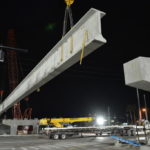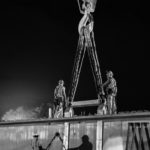- Company: The Lane Construction Corporation/DRMP, Inc. Design-Build Team
- Industry: Transportation
- Location: Orlando, Florida
- Expected Completion Date: October 1, 2015
- Project Website
This intersection is one of the most congested intersections in Florida with over 100,000 motorists traveling daily through the US 17-92/SR 436 corridor with motorists’ wait time clocking in at four to five-minute traffic light cycles. Just 13 miles north of the City of Orlando, Fla., the US 17-92/SR 436 intersection serves as a main route for commuter traffic as well as a major pipeline for motorists coming from Interstate-4. To alleviate congestion, the Florida Department of Transportation selected a Design-Build team to design a flyover bridge to alleviate traffic at the US 17-92/SR 436 intersection. The structure design implemented a groundbreaking bridge technology which required the fabrication, delivery and installation of the longest single-piece concrete beams ever fabricated and installed not just in Florida but the United States.
What impact does this project have on America?
Commuting in Orlando, Florida BEFORE Intersection Improvements and DURING Construction at US 17-92/SR 436
Just 13 miles north of the City of Orlando, Fla., the US 17-92/SR 436 intersection serves as a main route for 100,000 daily commuters as well as a major pipeline for motorists coming from Interstate-4, a major highway connecting Orlando to Florida’s East Coast. Before the intersection improvements, a commuter that drove through this intersection during peak travel times (6 am to 9 am and 4 pm to 7 pm) would experience three traffic light changes (over 10 minute wait time) compared to the ideal scenario of one traffic light change (2 minute wait time) to move through this intersection. To improve this intersection, the Design-Build Team worked together to implement a groundbreaking bridge technology to design and construct a 457-foot flyover bridge at US 17-92 over SR 436 using a 96” deep Florida I-Beam (FIB). The solution would lead to:
- • The unprecedented delivery and installation of the longest single-piece concrete beams ever fabricated and installed not just in Florida but the United States.
- • The bridge required the delivery of not one but 13 beams, each weighing in at 267,000 pounds, or slightly more than 45 full-grown elephants.
- • Maintaining traffic operations during construction required each beam to be delivered and set in place with cranes during the night.
- • The cranes had to avoid a main transmission overhead electrical line to set the beams in place, which if affected would have caused three different suburb cities (Altamonte Springs – 47K residents, Winter Park – 27K residents and Casselberry – 26K residents) and several large businesses like the Altamonte Shopping Mall and Full Sail University to lose power.
Commuting in Orlando, Florida AFTER Intersection Improvements at US 17-92/SR 436
This project is considered a community enhancing project for the local residents and businesses as well as the 100,000 daily commuters traveling through the intersection. Based on travel time savings and the average income in the Orlando area the intersection improvements will save approximately $25M per year in people and goods waiting in traffic every year. Commuters are now saving an average of 5 to 10 minutes in their travel time at the intersection since the motorists driving US 17-92 no longer have to stop for the traffic on SR 436 when they use the new flyover bridge to bypass over the busy intersection. The project was designed and constructed with a $2 million savings to the Owner and was delivered with a 25% reduction of the project schedule. Additionally, by opening the new flyover bridge early, it provides an alternate route for many of the daily commuters affected by the owner’s, Florida Department of Transportation, District Five, adjoining construction project, a $2 billion reconstruction of I-4. The project was featured in Aspire, The Concrete Bridge Magazine, with the title of “US 17-92 Interchange at SR 436: From Congestion to Concrete Innovation.”
What interesting obstacles or unusual circumstances did you overcome to complete the project?
Public Opposition from the Beginning
The project began with public opposition to the flyover bridge due to local area business owners believing that it would remove potential customers from their businesses. A “Stop the Flyover” movement was created by the public and was heavily covered by the media. As the project moved forward, the project team was able to overcome the public’s opposition. In the end, business owners were dropping by the onsite construction office to pay compliments on how the project was rapidly progressing and how it had ultimately turned out.
Overcoming Obstacles during Construction
The construction of the flyover bridge at the US 17-92 and SR 436 Intersection had two main obstacles, the first being the unprecedented delivery and installation of the longest single piece concrete beams ever fabricated and installed not in just Florida, but in the United States and secondly to not disturb a main transmission overhead electrical line during the installation. Each beam had to be delivered to where the bridge was being built and set in place with cranes during the night and did not interfere with the main transmission overhead electrical line while lifting and setting the beams in place.
Working closely with a Florida Department of Transportation (FDOT) approved pre-stressed concrete supplier, the delivery of the 13, 267,000-pound beams that had to be fabricated and delivered from their site in Leesburg, Fla was addressed. The supplier performed a detailed evaluation, coming up with the most cost-efficient route between their plant and the project site. With special trailers, capable of supporting 300,000 pounds, they delivered two beams each night, making the delivery a full week-long process. The entire US 17-92/SR 436 intersection was closed down and traffic was rerouted between off-peak hours, 11 pm – 6 am each day of that week, to accommodate the delivery. Due to the load the trucks were carrying, seven Florida Highway Patrol cars accompanied each truck, each night, to help ensure a safe and smooth delivery of the beams.
The construction team used two large cranes to lift the beams from the trucks and to place them onto the bridge supports. The cranes had to operate within a close distance to the relocated power lines. To maintain safety and an effective installation, the contractor implemented their own safety standards – that are greater than OSHA standards.
What dangers and risks did you encounter, and describe any extraordinary methods used to keep workers safe?
Worker Safety a Must
Bridge construction is always risky because it generally requires pile driving and the lifting of heavy beams. Sounds like just an average day on the construction site but a lot happens before any worker puts on their hard hat and steps foot on the site. For this project, there were several issues that made planning for worker safety that much more important. First, there were high voltage lines that had to be accounted for while piles were being driven into the ground by heavy equipment and then again when the concrete beams were lifted by the cranes and set in place. Therefore, careful attention was placed on exceeding the minimum OSHA clear zones in an effort to keep workers safe and produce the best possible work zone.
Extraordinary Beam Setting Operation
Secondly, the beam setting operation was extraordinary! The construction workers safely installed the longest concrete beams in the history of the United States. The Project Engineer and Assistant Superintendent used a 3D software to simulate the beam setting. Also, the Project Superintendent and the civil engineers developed a maintenance of traffic plan to close down one of the busiest intersections in Florida and safely rerouted vehicular traffic during the nightly closures. The project team had to take into special consideration the high voltage power lines directly over the 267,000-pound beams, close proximity of signalization mast arms, complete closure of the entire intersection, exact locations of the massive cranes, and the precise positioning of the beam deliveries prior to setting. Not only was the construction company able to develop a pick-plan for this record setting activity with the 3D software, they were able to visualize the work before it actually happened. Construction personnel were able to review the steps internally with their project team members and also were able to share the details of the work with the FDOT which enabled a flawless installation.
How did you leverage new technologies to work faster and reduce waste?
Delivering a Complex Project with Design-Build:
Partnering to design and construct this project began even before the Design-Build Team was selected to deliver the project. While vying for the opportunity to win the project, the engineers from the design firm and the construction personnel from the contractor began working together to find the best design and construction approach to present to the Owner to be given the opportunity to win the project. Knowing the competition would be tight, the team of professionals pored over several different approaches to the project and ultimately chose to use concrete over steel for the bridge. The team was ultimately selected to perform the work and their project approach continued to provide savings to the Owner. The benefits of concrete coupled with lower upfront material costs, resulted in a savings of approximately $2 million, not including long term maintenance costs.
Additionally, the project team faced other important factors of how to maintain traffic through the construction on such a heavily traveled corridor and how to address the extreme public concern over the impacts the project would have on area businesses. Faced with these variables, the staff of the FDOT, contractor, designer, and the FDOT’s construction engineering inspection team all sat down together and created a set of team goals for the project. With these team goals in place, each stakeholder was able to maintain open lines of communication and coordinate efforts as a team rather than as separate entities needing to get a job done.
Ultimately, by combining the designers and construction personnel together with the added support of the other stakeholders, the project was delivered 30 days ahead of schedule, with $2 million dollars in savings to the Owner, a groundbreaking bridge technology was used and the successful installation of the longest prestressed concrete beams in the United States was completed. This all resulted in an improved intersection with minimum disruption to the daily commuters.
New bridge technology
The 96” Florida I-Beam was a new design standard and had never been designed, fabricated, delivered and erected in the state of Florida. The implementation of this beam saved the owner $2 million and reduced the project schedule during the bridge installation phase by 25%. The benefits of using this new design standard included the elimination of using shoring towers on the bridge, improved the maintenance of traffic allowing the roadway to remain open during construction, improved aesthetics providing a more pleasing view for the citizens and local businesses, and reduced maintenance costs for the Owner. This project was the first one to be designed and constructed with this new bridge technology in Central Florida as well as within the entire state of Florida.
3D Crane Software
Before construction even began, the Contractor used 3D modeling software to develop a beam erection plan. This measure was taken for several main factors including the size of the beams, the relatively small work zone, adjacent traffic, and the proximity of overhead electric transmission lines. Going through the process of simulating the entire beam erection and showing the location of the overhead electric lines ensured there were no issues prior to any construction starting on the project. The simulation was presented to all construction workers on the project to provide a “real time view” of how the work efforts would be performed for the beam erection before any workers ever set foot on the construction site.









